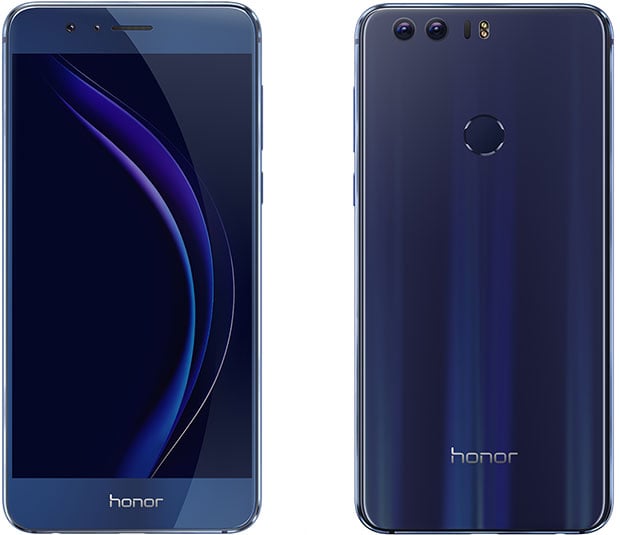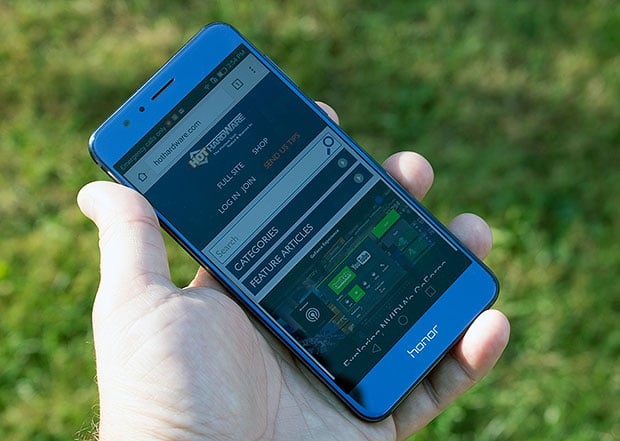Huawei Honor 8 Review: A Stylish, Affordable Android Smartphone
Huawei Honor 8 Introduction And Specs
Electronics manufacturer, Huawei (pronounced "wah-WAY"), has been around for a very long time. It's the largest telecommunications company in the world, actually, though it doesn't have the same brand recognition in the US versus competitors like Apple, Samsung, or Motorola. We won't delve into all of the politics surrounding the situation, but will note that part of the reason Huawei's consumer footprint in the U.S. isn't more significant is because buyers have been caught in the crosshairs of a strained relationship between the U.S. and China in the tech sector. There's even a ban in place preventing Huawei from bidding on networking equipment contracts for the U.S. government over fears of spying.
Suffice to say, that's made things a bit awkward, though Huawei is on a mission to become the biggest brand in smartphones within the next five years. It may not necessarily need a significant U.S. presence to achieve that goal, but it would certainly help. It could even benefit American workers—each year Huawei invests about a third of its U.S. revenue (30 percent) into local innovation, tallying $276 million in 2011.
"Since we began operating in the United States, we have invested over $800 million in U.S. based R&D. Our 13 facilities contribute to the local and state economies in which we operate, and 75 percent of all hires are local, including key technical leaders, senior managers, and executives. Huawei has purchased more than $30 billion in goods and services from nearly 300 U.S. based technology providers since 2006," Huawei points out on its website.
It may seem as though we're burying the lede here, a big no-no in journalism. After all, we're evaluating Huawei's Honor 8 smartphone and not the company itself. However, it is important to understand why Huawei isn't more widely known in the U.S., lest there be an assumption that its products aren't up to par. That isn't the case, and in fact the Honor 8 we have in for review is proof that it would certainly be beneficial if Huawei continued its recent effort into expanding its presence on American soil. The Honor 8 is what we consider a premium built, mid-range handset, and one that puts the pressure on competing smartphone makers to continue innovating if they're to convince buyers to spend several hundred dollars more on a flagship product.
Priced at $350 currently on Amazon, the Honor 8 looks and feels like a more expensive phone. It's also fairly well equipped with a Hisilicon Kirin 950 SoC boasting an octa-core processing engine with an i5 co-processor, 4GB of RAM, and 32GB of built-in storage that you can expand with a microSD card. That right there is a potent foundation held back a little perhaps only by the ARM Mali-T880 MP4 GPU compared to processors like the Snapdragon 820 with Qualcomm's Adreno 530 graphics engine found in devices like Samsung's Galaxy S7. But hey, this is a $350 phone, so there's bound to be a few subtle compromises along the way.
While some smartphones come in different SKUs with various amounts of RAM and storage, all Honor 8 phones feature the same 4GB of RAM and 32GB of built-in storage space. It also ships in one size, with a 5.2-inch display with a Full HD 1080p (1920x1080) resolution. That works out to a pixel density of 423 pixels per inch.
Suffice to say, that's made things a bit awkward, though Huawei is on a mission to become the biggest brand in smartphones within the next five years. It may not necessarily need a significant U.S. presence to achieve that goal, but it would certainly help. It could even benefit American workers—each year Huawei invests about a third of its U.S. revenue (30 percent) into local innovation, tallying $276 million in 2011.
"Since we began operating in the United States, we have invested over $800 million in U.S. based R&D. Our 13 facilities contribute to the local and state economies in which we operate, and 75 percent of all hires are local, including key technical leaders, senior managers, and executives. Huawei has purchased more than $30 billion in goods and services from nearly 300 U.S. based technology providers since 2006," Huawei points out on its website.
It may seem as though we're burying the lede here, a big no-no in journalism. After all, we're evaluating Huawei's Honor 8 smartphone and not the company itself. However, it is important to understand why Huawei isn't more widely known in the U.S., lest there be an assumption that its products aren't up to par. That isn't the case, and in fact the Honor 8 we have in for review is proof that it would certainly be beneficial if Huawei continued its recent effort into expanding its presence on American soil. The Honor 8 is what we consider a premium built, mid-range handset, and one that puts the pressure on competing smartphone makers to continue innovating if they're to convince buyers to spend several hundred dollars more on a flagship product.
Priced at $350 currently on Amazon, the Honor 8 looks and feels like a more expensive phone. It's also fairly well equipped with a Hisilicon Kirin 950 SoC boasting an octa-core processing engine with an i5 co-processor, 4GB of RAM, and 32GB of built-in storage that you can expand with a microSD card. That right there is a potent foundation held back a little perhaps only by the ARM Mali-T880 MP4 GPU compared to processors like the Snapdragon 820 with Qualcomm's Adreno 530 graphics engine found in devices like Samsung's Galaxy S7. But hey, this is a $350 phone, so there's bound to be a few subtle compromises along the way.
We'll talk more about performance in the benchmarks section, but first here's a look at the spec sheet followed by a tour of the Honor 8's eye-catching design.
|
| Size | Height: 145.5mm; Width: 71mm; Depth: 7.45mm; Weight: 153g (w/ battery.) |
| Colors | Pearl White; Sapphire Blue; Midnight Black |
| Display | 5.2" Full HD Screen 1080p (1920 x 1080), 423ppi 16.7 million colors; color saturation (NTSC) 96% |
| CPU | Hisilicon Kirin 950 (64-bit,16nm FinFET+), Octa-core (4 x Cortex A73 @ 2.3GHz + 4 x Cortex A53 @ 1.8GHz) + i5 co-processor |
| Operating System | Android Marshmallow 6.0 With Huawei Emotion UI 4.1 |
| Memory | 4GB RAM + 32GB ROM |
| Network | 4G: LTE FDD/HSPA+ (B1/B2/B3/B4/B5/B7/B8/B12/B17/B20) 3G: WCDMA (B1/B2/B4/B5,B8) 2G: GSM (850/900/1800,1900MHz) |
| Data | LTE FDD Category 6: 51.0 Mbit/s (UL), 301.5 Mbit/s (DL) WCDMA: 384 Kbit/s (UL), 384 Kbit/s (DL) HSPA Category 24: 5.76 Mbit/s (UL),42 Mbit/s (DL) EDGE Class 10: 118.4 Kbit/s (UL),236.8 Kbit/s (DL) GPRS: 40 Kbit/s (UL), 60 Kbit/s (DL) |
| GPS | GPS/A-GPS/Glonass |
| Connectivity | Wi-Fi: 802.11ac, 2.4GHz and 5GHz, hotspot up to 8 devices Bluetooth: 4.2 BLE USB 2.0 /w USB Type-C Interface |
| Sensors | Fingerprint Sensor, Accelerometer, Ambient Light Sensor, Proximity Sensor, Compass, Gyroscope, Infrared Sensor, NFC, Hall |
| NFC | NFC supported |
| Camera | Main camera Dual 12.0-megapixel (monochrome + color), f/2.2 Digital zoom Video recording: 1080p, 30 fps Front camera 8-megapixel, f/2.4 Video recording: 1080p, 30 fps |
| Battery | 3000mAh (typical value) |
| In the box | Handset; Headset; Charger; USB cable; Quick Start Guide; Safety Information |
| Pricing | $349.99 - Find It At Amazon |
While some smartphones come in different SKUs with various amounts of RAM and storage, all Honor 8 phones feature the same 4GB of RAM and 32GB of built-in storage space. It also ships in one size, with a 5.2-inch display with a Full HD 1080p (1920x1080) resolution. That works out to a pixel density of 423 pixels per inch.
On the software side, the Honor 8 is pre-installed with Android 6.0 Marshmallow glazed with Huawei's custom EMUI 4.1 interface skinned on top. Rumblings on the web suggest that both will be updated relatively soon to Android 7.0 Nougat and EMUI 5, though nothing official has been announced yet. Huawei's track record is pretty good though, so we wouldn't be surprised to see it updated by the end of the year (we're speculating here).
Finally, vendors often advertise the Honor 8 as an unlocked handset, though note that of the four major wireless carriers in the U.S. it only works with AT&T and T-Mobile (this is a GSM device). It is not compatible with Verizon and Sprint.
Let's keep things rolling, shall we? Onto the design and build quality.
Finally, vendors often advertise the Honor 8 as an unlocked handset, though note that of the four major wireless carriers in the U.S. it only works with AT&T and T-Mobile (this is a GSM device). It is not compatible with Verizon and Sprint.
Let's keep things rolling, shall we? Onto the design and build quality.








